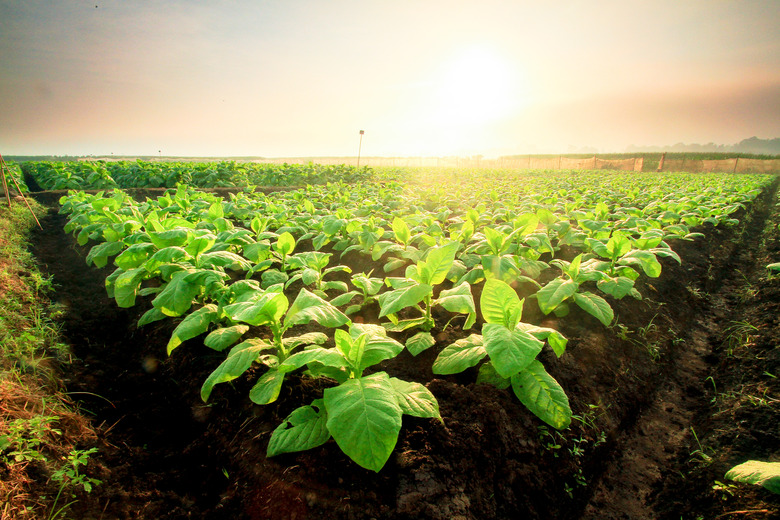Colonial Carolina's Natural Resources
Like all of the English colonies in North America, Carolina's economy was largely constricted by mercantile laws that prohibited the manufacture of finished goods in the colonies and promoted the export of raw materials to England to feed the Colonial power's growing industrialization. Combined with the conditions of settlement of the southern colonies by agricultural interests, the Carolinas quickly became a plantation economy. Both South and North Carolina economic activities became highly specialized in the production of agricultural products as natural resources.
Tobacco's Role in North Carolina Economy
Tobacco's Role in North Carolina Economy
Although the price of tobacco was quite volatile in the Colonial period, a growing demand for the product in Europe led Carolina's plantation farmers to specialize in the product, exporting huge amounts of the plant to Europe. Tobacco was the leading cash crop in many of the southern colonies and, though Carolina's production lagged behind Virginia's and Maryland's, the crop became the colony's most important commercial crop, sometimes even forcing the colony to import food supplies because so much of its land was occupied by tobacco fields. In contrast, the economies of the northern colonies- such as the New York Colony economy- were based on smaller, more diverse family farms.
Indigo and Rice in South Carolina
Indigo and Rice in South Carolina
Because of volatility in the tobacco market, the Colonial economy of the Carolinas also began to develop other crops for potential commercial use. England discouraged the growth of Colonial cotton agriculture to protect the emerging English textile industry, but Carolina soon began growing large amounts of indigo, a plant used to create blue dye, for export to England and use in English textile manufacturing. Carolina's plantations also experimented with rice production for internal consumption and for export to other colonies and Europe.
Livestock Production
Livestock Production
Colonial Carolina was predominantly an agricultural plantation economy, yet historical records also reveal an early development of livestock, particularly pork. At the time, meat could not safely be exported across the Atlantic, but a growing cattle and hog industry drove significant local consumption, exports of livestock to other colonies and small trans-Atlantic exports of salted or cured meats. Unlike cattle, hogs take up relatively little space for feeding, allowing agricultural land, Colonial Carolina's indisputably most important natural resource, to continue to be used for agricultural cash crops rather than grazing.
Other Natural Resources
Other Natural Resources
Within an agricultural economy, Colonial Carolina made some limited use of mineral and forestry products as natural resources. The northern colonies far outpaced Carolina in the production and export of these products, but Carolina did produce some amounts of products like lumber, tar, pitch and turpentine. The vast forests of Carolina were considered far less valuable resources at the time than agricultural land, yet, if only while clearing forests to create more agricultural land, historical evidence indicates that some of these forest and mineral resources were commercialized.
Cite This Article
MLA
Mercer, Edward. "Colonial Carolina's Natural Resources" sciencing.com, https://www.sciencing.com/colonial-carolinas-natural-resources-8329601/. 22 November 2019.
APA
Mercer, Edward. (2019, November 22). Colonial Carolina's Natural Resources. sciencing.com. Retrieved from https://www.sciencing.com/colonial-carolinas-natural-resources-8329601/
Chicago
Mercer, Edward. Colonial Carolina's Natural Resources last modified March 24, 2022. https://www.sciencing.com/colonial-carolinas-natural-resources-8329601/
